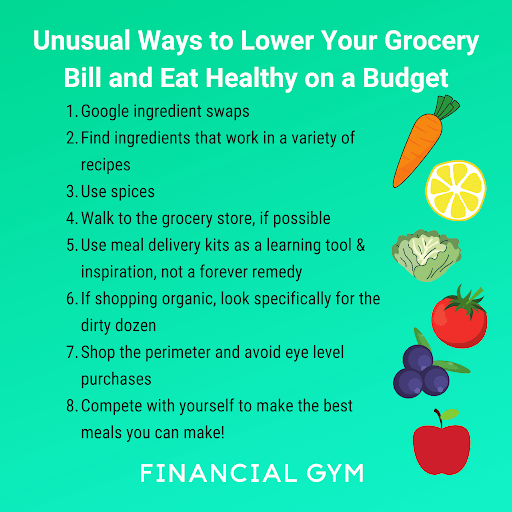Unusual Ways to Lower Your Grocery Bill
Eating is something we all do on a regular basis. In fact, the Department of Labor Statistics ranks food costs as the third largest expense category just behind transportation, with housing coming in first. And since it’s not very likely that you can just up and change your housing and transportation costs anytime soon, that leaves food as the biggest category that we can control on a regular basis.
That’s why I am going to share my favorite, yet unusual ways I drive down my food costs. You can think of this as “Food Budgeting Tips and Tricks 201,” so if you still need to work on the basics, this article is a great place to start!
1. Google ingredient swaps
Oftentimes, new recipes will call for an ingredient that you wouldn’t otherwise buy. This can be exciting and fun, until you realize the ingredient is only sold in packages far larger than you actually need. That ingredient alone can ruin your otherwise cost effective meal plan, especially if you don’t know how to use the ingredient in other dishes.
Next time, before you go out and buy that costly item, hop on Google and see what alternatives you can swap in that you may already have in your pantry.
2. Find the common denominator
Especially if you are food shopping for just one or two people, it can be frustrating when you buy a whole head of cauliflower or a bunch of collard greens, knowing it’s more than you need for a given recipe. One option is to freeze the portion you won’t be able to eat before it spoils, but that’s not always practical and some foods don’t thaw well. An alternative is pairing recipes together that share ingredients.
For instance, you could make a curry and a pasta dish in the same week and top them both with the cauliflower and collards greens that would normally go bad. When you master this you’ll feel like there is a lot of variety in your menu, and you’ll also cut back on food waste!
3. Use spices
Spices can seem pricey at first glance, but they can totally transform a meal and make it more enticing to eat more home cooked food. This instantly results in a return on your investment.
If you typically turn to delivery or eating out because your home cooked meals just don't taste as good, the missing piece could be spices!I recommend you start with just a few spices that you love and slowly incorporate new flavors when you need to change things up. If you aren’t sure what your favorite spices are, take a look at recipes for your favorite meals that you enjoy and look for recurring spices.
4. Walk to the grocery store, if possible
The practicality of this suggestion is definitely location dependent, but the idea behind it is not. When you walk to the grocery store, you can only buy the amount that you can carry home. This means you must stock up on things that will sustain you until your next trip and leave behind the things that won’t.
If you can’t walk to the grocery store, consider using a basket instead of a cart, as this also creates physical limitations on how much you can stock up on.
5. Use meal delivery kits as a learning tool & inspiration, not a forever remedy
Meal delivery kits are a fabulous way to learn how to cook for beginners or a fun way to change it up with a meal you wouldn’t otherwise cook, but don’t rely on them forever. After using a meal delivery kit once, recreate that dish on your own!
Additionally, meal delivery kits don’t give you the wiggle room you may desire when it comes to portion size. Purchasing the ingredients for the recipes yourself will not only be cheaper per item, but also allow you to pick the exact amount you want!
6. If shopping organic, look specifically for the dirty dozen
Deciding to shop and eat organic is often a personal choice. If you’d like to eat organic but your budget can’t quite keep up, focus first on the dirty dozen. These items have been proven to have the greatest difference between organic and non-organic, therefore have the most justification behind the increased cost.
7. Shop the perimeter and avoid eye level purchases
Typically, the center of grocery stores are filled with the more expensive and less fulfilling items such as cookies, instant meals, chips, and even healthy snacks like granola bars. Reworking your shopping list so that a majority of it comes from the perimeter of the store in the produce section, the deli, and the essential freezers will result in instant savings.
But when you do have to venture into the aisles, remember to look above and below eye level. Strategically, stores place the most expensive brand-name items at eye level. By looking up or down a few shelves, you can usually find the same item for a lower cost.
8. Compete with yourself!
Lowering your grocery bill can be a fun game that you play with yourself. Set specific goals like aiming to spend $1 less each time that you go to the store. If you hit an all-time low for a full grocery haul, pin it to the fridge and see if you can beat that!
Ready to take your finances to the next level?
To get started schedule a free 20 minute consultation call to speak to a member of our team. We will ask you a few basic questions to get to know you more, walk you through our financial training program steps, and of course answer any questions you may have. No pressure to join!

